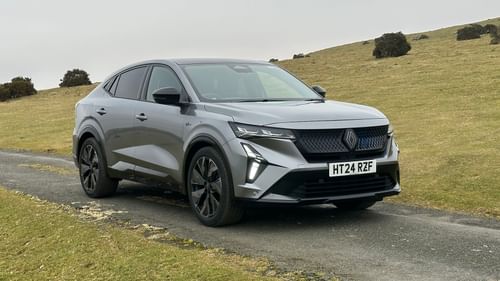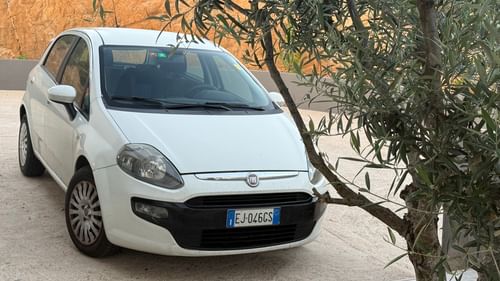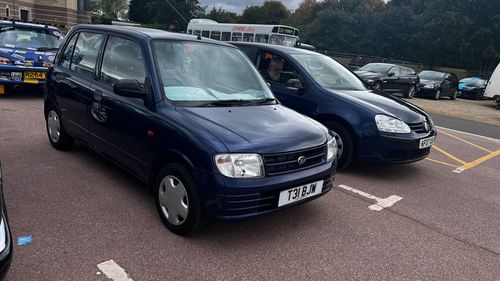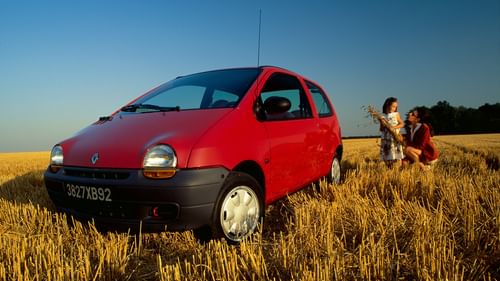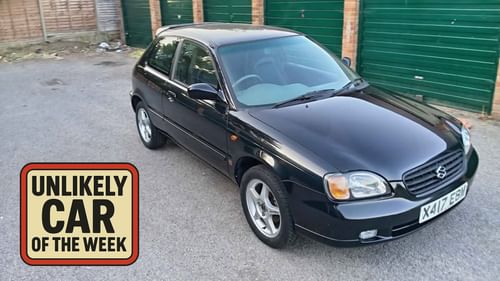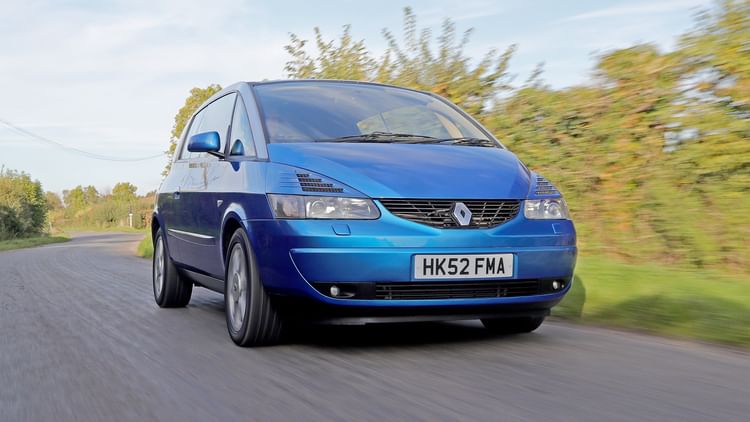
We’re in the presence of #WeirdCarTwitter royalty. While Bilbao’s Guggenheim Museum or the basement of the Louvre would be a more fitting backdrop than a collection of farm buildings betwixt the M5 motorway and River Severn, it’s impossible not to be awestruck by the regal Régie.
A couple of decades on from its premature demise, the Avantime still stops many of us in our tracks. Renault’s design chief Patrick le Quément once said that it was ‘a vehicle that marked its era’, but while the Avantime is clearly ‘of its time’, there are shades of its approach in today’s breed of SUV coupés, although Renault delivered it with greater levels of purity and authenticity. Dare we suggest that the Avantime looks even better today than it did at its launch in 2001? That’s quite an achievement for a design-led car.
The Avantime story begins with the Vel Satis concept of 1998, designed to commemorate Renault’s 100th anniversary. Although it would lend its name to the production Vel Satis, introduced four years later, the concept car also offered hints of the Avantime, including the vertical, panoramic rear window above the bustle-back rump, glass roof, clever door hinge arrangement to allow ease of access to the interior, plus the absence of B-pillars. Those who argue that the Avantime’s styling was too radical for a largely conservative audience should remember that the Mégane II, launched in 2002, did great numbers for Renault, with annual sales peaking in 2005 at around 465,000. We put it to you that a three-door Mégane II with a panoramic sunroof is a fun size version of the Avantime. Talking about the Mégane III in an interview with The Surge, Le Quément said: ‘… with Mégane III’s exterior design approval, we were celebrating a feat equivalent to climbing three flights of stairs in our local mall – but it could not compare to the landmark design contribution of the Mégane II, which had been a heroic and spectacular ascension to the very top of the Eiffel Tower.’ Which must have made the decision to put the Avantime into production feel like reaching the summit of the Warsaw Radio Mast. Parallels could be drawn with the Avantime’s slow sales and the fact that the 2230ft structure collapsed in 1991, but we won’t go there.
For now, we’re just happy to be spending quality time with the Renault. Thierry Métroz, the Frenchman who penned the exterior design, said: ‘We wanted someone walking around the car to be continually astonished. When you look at the front, you can’t imagine what the back will be like, and vice versa. The Avantime exploits those contrasts, between a figurehead of an animal and a solid, forceful stern.’ There’s some truth in that, although the size is less of a shock today than it would have been in January 2002 when the Avantime arrived in the UK. At 4642mm long, 1826mm wide (without mirrors) and 1627mm tall, it’s broadly similar in dimensions to the current Nissan Qashqai, albeit with an additional 217mm tagged on to the rear. It always did have a shapely (read: protruding) ‘ass’; the American spelling of the word deployed to pay homage to the famous TV advert for the Mégane II.
In simple terms, the Avantime is a coupé body perched on an Espace III platform. That shouldn’t work, but the result is more cohesive than it has any right to be. The front is sporty, bordering on aggressive, while the derrière is dominated by the vertical glass and the kite-like lights, which echo those of the Fiftie concept car of 1996. In profile, the Avantime is dominated by the abnormally long doors and the aluminium upper structure, left exposed to create a two-tone effect. Time hasn’t diluted its appeal or reduced its impact; it looks as crazy today as it did two decades ago.
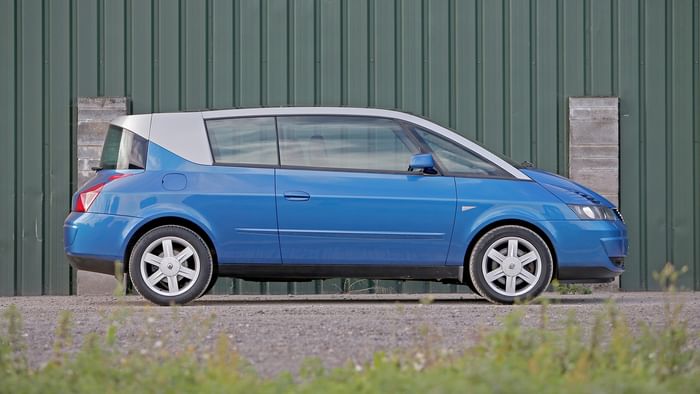
Which is where we must go to understand the reasons for its introduction and why it was, commercially at least, a failure. Matra, which had previously attempted to carve out a new niche in the shape of the Rancho, had been served notice that Renault would be taking production of the Espace in house at its Sandouville plant. This would have left a gaping hole at Matra’s plant in Romorantin, where the first three generations of Espace had been built since 1984. In a Renault promotional video marking the tenth anniversary of the Avantime, Philippe Guedon, head of Matra’s automobile division, said: ‘As the years go by, kids leave home, which is completely normal. But this leaves mum and dad with less need for space. But they’ve got used to driving a car that first attracted them by its visibility and ease of operation. So, we thought, after the Espace, we had an opportunity to create a vehicle with some of those basic characteristics, but with a different focus: one centred on their needs. We decided to present Renault with an idea for a coupé. A four-seater with just three doors. It would be an extension of the Espace but in a different class.’
It was a meeting of minds, with Patrick le Quément noting: ‘We also had an idea for a car that opened up to the exterior. One that offered four comfortable seats, with 360 degrees of visibility, top to bottom, and from every angle. And that had never been done before.’ Carole Hurel, Avantime product manager (2000-2002), added: ‘It’s a bit like going from the small screen to the theatre. We saw this as an extremely creative contribution to the auto industry. It’s not your typical car. If you’re one of the crowd, it’s not for you. But those who chose the car wanted to display their lifestyle. We certainly took a risk!’.
‘Risk’ isn’t a word you’d want to hear if you were one of the 20,000 people who lived in a French town where 10 percent of the population were employed at the Romorantin plant. Which is why there was so much at stake when members of the press were invited to the Louvre basement in February 1999 for the unveiling of Renault’s… well, nobody quite knew what it was. A month later, it made its debut as a concept at the Geneva show, before premiering as a production model just six months later in Frankfurt. Renault said it was ‘redefining the meaning of luxury motoring for the future’, claiming it would be on sale in the UK ‘towards the end of 2000’. Both predictions proved to be wildly optimistic.
Delays meant that the Avantime didn’t go on sale in Europe until 2001, not arriving here until early 2002. By then, both the Vel Satis and Espace IV had hit the market, lessening the impact of Renault’s ‘futurecoupéspacegrandtouringmpv’. Worse still, the Avantime was riding on the platform of the outgoing Espace and powered by the old 3-litre V6 engine, not the new Nissan-sourced 3.5-litre V6 of the Vel Satis. Being on the back foot isn’t ideal when you’re hoping to convince people that your car represents the future of luxury motoring; there must have been a few sleepless nights in Romorantin.
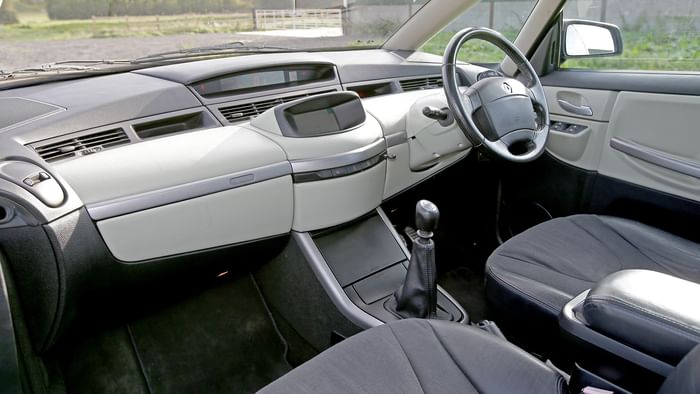
With the benefit of hindsight, it’s not difficult to see why the Avantime was delayed. The project got underway in May 1998, overseen by the head of Advanced Design, Michel Jardin, under the authority of le Quément. In just a couple of months, Métroz (exterior) and Stéphane Janin (interior) had finalised the design, which led to the production of a prototype based on a shortened Espace platform. There’s a reason why concept cars rarely make production without significant changes – the Avantime would demonstrate that.
The problem of maintaining a low centre of gravity in a car with a largely glass roof and without B-pillars was solved by the aluminium structure, but the doors – the largest fitted to a production car – would create a bigger headache. You can’t claim the car has ‘space for four adults to relax and travel in comfort’ if accessing the back seats requires the dexterity of a contortionist and the burrowing skills of a potholer. To this end, the doors would need to be the size of the wings of an Air France Airbus A319; fine if you’re taxiing on the runway at Paris Charles de Gaulle, but not great if you’re parked between a Twingo and a Scénic at Carrefour. The solution was the creation of a complex double hinge mechanism called ‘double kinematic’, which opened wide enough for passengers to enter the car in a tight parking space. There were other complex issues to overcome, including the sealing of the door’s frameless windows and the fitment of seatbelts integral within the front seats, which meant the Avantime was less ‘ahead of time’ and more ‘hors de temps’.
Renault had hoped to showcase the Avantime to the press at the Guggenheim Museum, but although some publicity photos were taken in Bilbao, the launch took place in June 2001 on the oh-so-trendy streets of Berlin. Writing for CAR, Paul Horrell said: ‘My betting is on the Avantime selling more and more as it goes into middle age, eventually spawning imitators.’ We’d make a quip about Horrell forgetting to pack his crystal ball for the flight to Germany, but we’re too busy dreaming of a world in which the ‘Coupéspace’ is the dominant player in the family car market. ‘It may or may not be better to travel than to arrive, but, whatever, it’s better to travel by Avantime,’ he concluded.
The Telegraph’s Peter Dron agreed, saying: ‘With its three-pronged attack – Vel Satis, Espace and Avantime – Renault may have found a lever to turn the luxury market on its head. The Avantime concept is brilliant. However, to draw people into it from whatever the opposition consists of, the French company needs to rethink several aspects of comfort, visibility and quality control.’ He was referring to the comfort for rear-seat passengers, which he described as ‘disappointing to anyone who has been chauffeur-driven in a Safrane’. Dron also criticised the ‘unpleasantly clunky’ six-speed gearbox, the ‘irritating shunt in the power delivery’ and feeling of ‘sitting in a microwave oven’. Ray Hutton, writing for Car and Driver, was more convinced, praising it for being ‘fun for the driver and calm and secure for the passengers’, while applauding Renault for ‘daring to be different’. Quite right.
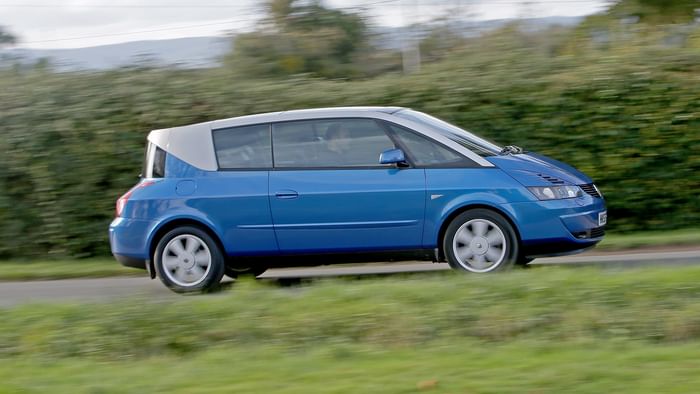
Unfortunately, being different doesn’t necessarily result in success. Sales limped to just 8557 in just 18 months, which is roughly the figure Renault expected to sell in Europe every year. Phillipe Guedon said: ‘We stopped production at about 8000 cars in total. That’s obviously not a lot in terms of automobile production. We weren’t able to develop it further and get the best out of it. Needless to say, I have regrets about that.’ Thierry Métroz hit the nail on the head, saying: ‘It’s like a couture dress; everyone finds it magnificent, but no one is actually ready to wear it.’
Before we can strut our stuff on the unbroken and undulating catwalks of rural Gloucestershire, it’s time to get comfortable in a cabin that’s rivalled only by the Towns Hustler for natural light. Stick a Levington Gro-Bag on top of the dashboard and you’ll have a crop of tomatoes in no time at all. Which is good, because the interior is a bit of anti-climax. The bold exterior styling heightens your expectations, but the cabin takes things down a peg or two. Twenty years on, a raised driving position has become the new normal, while the dashboard layout and controls ‘hidden’ behind panels will be familiar to anyone who has spent time in an Espace IV or – and, yes, we’re going there – a Laguna II. If only Renault had finished the Avantime beforethe Espace IV broke cover (to borrow an overused motoring writing cliché). In fairness, the hard plastics in the Avantime are far from offensive and have stood the test of time better than the rubberised controls found in other European cars of the period. Criticising the interior for its sticky surfaces and hollow plastics would be to overlook the fact that the car stems from the turn of the millennium. Less forgivable is the unsatisfactory ‘clunk’ when you shut the door; a ‘thud’ would be preferable.
For all its space-age wonderment, the dashboard layout is blissfully logical. The climate control buttons are located on a panel to the right of the steering wheel, while the primary controls are found on a pair of stalks. The orange instrumentation sits high in the centre of the dash beneath a cowling to protect it from the sunshine. It’s classy without being ostentatious. You expect hinged panels to rise up and disappear into the dashboard when you twist the ignition key, but, no, it’s just the sound of the 2-litre turbocharged petrol engine firing up. Alas, we’re not at the wheel of the more desirable 3-litre V6 version, but in the cooking four-cylinder version. A 2.2-litre diesel was sold in Europe but never made it to these shores.
Once on the move, we’re struck by how normal it feels. It’s more ‘MPV’ than ‘coupé’, but the Avantime does a terrific job of disguising its Espace underpinnings. With just 55,000 miles under its belt, the 2-litre engine feels tight, and despite being down on power – 165bhp rather than the 210bhp of the V6 – it doesn’t feel slow. It helps that the gearbox is surprisingly satisfying, although we’re left with the sense that a 3-litre engine mated to an automatic ’box would be prime Avantime. The driving position is excellent, although on roads ravaged by recent floods, the persistent creaks and groans from the dashboard become more than a minor irritation. To say the driving experience is underwhelming would be unfair, but it’s unable to live up to the promise of the styling. Maybe we expected too much…

Then, everything changes. The driving experience is transformed from humdrum to heroic with the help of a button marked ‘Open Air’. Press it, and the sunroof slides back, the side windows disappear into the body, and fresh air pours into the cabin. Suddenly, it’s as though we’re enjoying a leisurely cruise on the Severn, rather than dodging the potholes on the roads near Berkeley Castle. With unobstructed views to the side and looking at the big sky above, the Avantime finally delivers on its promise. There are some cars you’d buy on the strength of the engine, the handling, the comfort or the technology; the ‘Open Air’ button is the Avantime’s USP. Its intoxicating and addictive. And as everybody knows, fresh air is good for the soul; driving an Avantime does wonders for your mental health. Judging by the smiles and nods of appreciation from pedestrians and other drivers, the Avantime is also more socially acceptable than other MPVs and modern SUVs.
Unfortunately, just 400 Avantimes were registered in the UK, as too few people were willing to take a punt on Renault’s and Matra’s vision of the future. How many times have you dined on haute cuisine only to end the evening feeling hungry and yearning for a plate of pie and mash? How many extravagant pads have you admired on Grand Designs before muttering something about preferring your three-bed semi? Tailored suits and high heels have their place, but there are times when you just want to slum it in a pair of jogging bottoms, an oversized jumper and a pair of slippers.
The Avantime was just too radical for a conversative, conventional and conformist audience. Unlike the Rancho, which was simply the right car at the wrong time, the Avantime is an example of an experiment that failed to hit its target. Deciding whether this was due to the delayed launch, the obsolete platform or the quality-related issues is irrelevant. Let’s appreciate the Avantime for its fresh thinking, bold design and overall Frenchness. It’s a modern classic – and not before time.
This article first appeared in issue 22 of Classic.Retro.Modern. magazine
